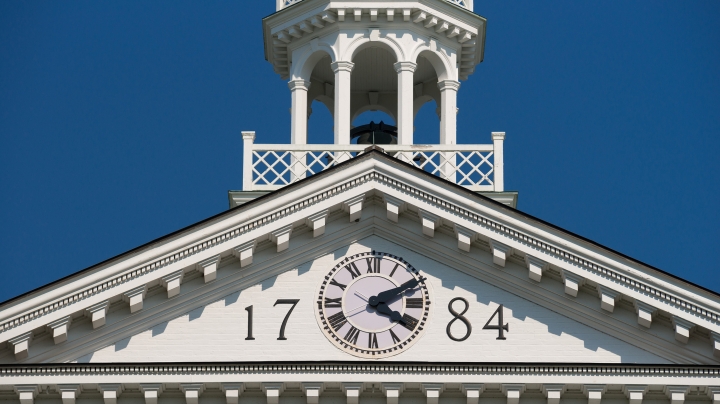The Campus Iconography Working Group has begun work to draft recommendations for artwork, images, and nomenclature across Dartmouth’s physical and digital environments. The group, which includes students, faculty, staff, and alumni, will consider items such as paintings, sculptures, statues, and official insignia.
The 12-member group is charged with developing recommendations for an inclusive process of outreach and consultation regarding the placement, presence, and official recognition of campus iconography. These recommendations will articulate guidelines for institutional decision-making that reflect Dartmouth’s traditions, promote historical accountability, and align with the core values and aspirations of the institution. Gathering input from people, groups, and organizations whose perspectives reflect the diverse experiences of the Dartmouth community will be a vital component of its mission. (Complete text of the charge appears below.)
As part of its process, the working group will provide an outline of best practices that are informed by scholarship in higher education. Its co-chairs are Mary Coffey, a professor of art history, and Amelia Kahl ’01, the Barbara C. and Harvey P. Hood 1918 Curator of Academic Programming at the Hood Museum of Art.
The working group was formed this winter at the request of President Philip J. Hanlon ’77 following his decision last summer to remove the copper weather vane from atop Dartmouth Library’s Baker Library Tower. The outdated, and to many, offensive, image of a Native American on the vane had been in place for nearly a century despite calls for its removal.
The work of the group will include a recommendation regarding an alternative to the weather vane.
“Iconography is an expression of what matters to an institution,” says President Hanlon. “It is important that the symbols and artifacts we choose to elevate reflect our institutional values, our history, and the inclusivity of our community. The working group’s recommendations will serve as an important guide for future decision-making around how we tell our story authentically and with accountability.”
To gain insight into how similar issues could be adjudicated in the future, the working group will use the weather vane’s removal as a case study. That will involve analyzing the piece itself and examining the national and local issues that prompted its removal, including the history of widespread misrepresentation of Native Americans and calls over the years for the weather vane to be taken down.
Working with Coffey and Kahl are group members Justin Anderson, vice president for communications; Peter Carini, the College archivist and records manager; Eileen Cave ’76; Eitan Darwish ’21; Dawson Her Many Horses, Tuck ’10; Deborah King, an associate professor of sociology; Jordan McDonald ’21; San’Quan Prioleau, Web Services; David Spalding ’76; and Melanie Taylor, a professor of Native American studies.
For community members interested in sharing their views on campus iconography, traditions, and history around Dartmouth’s campus, please complete this request for input.
Campus Iconography Working Group Charge
President Philip J. Hanlon’77 has convened Dartmouth’s Campus Iconography Working group to consider, among other things, paintings, sculptures, statues, and official insignia across the college’s physical and digital environments.
The working group will:
- develop recommendations for outreach and consultation about the placement, presence, and official recognition of iconography on campus
- articulate guidelines for institutional decision-making that promote historical accountability and align with Dartmouth’s core values and aspirations
- outline best-practices that are informed by scholarship and evidence-based processes in higher education
- gather input from perspectives that reflect the diverse experiences of the broad Dartmouth community
- seek to understand and represent Dartmouth’s history and traditions while enabling a dynamic, inclusive, and intentional process of place-making

